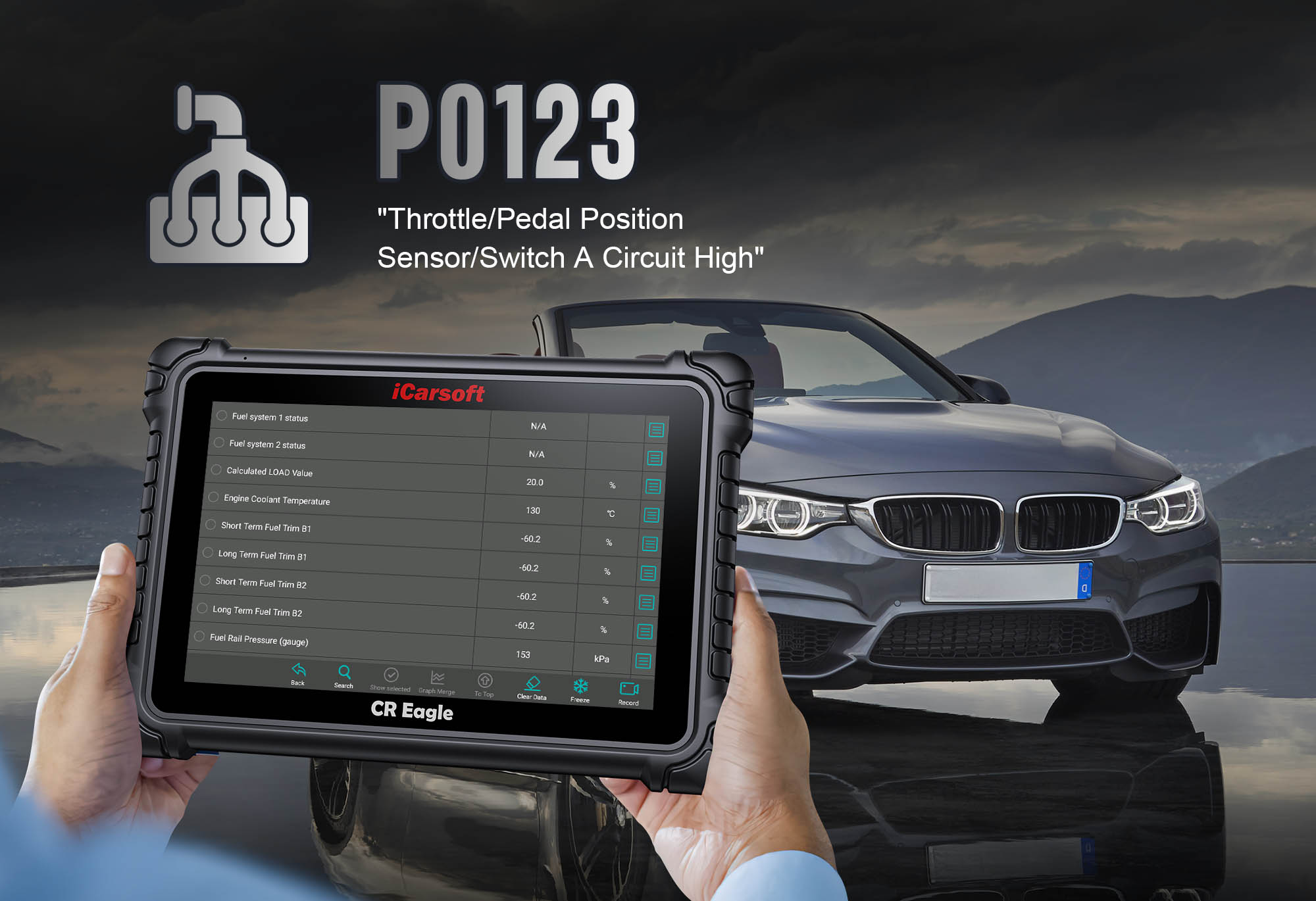Diagnose and Clear P0123: Fix Throttle Position Sensor Circuit High Voltage with iCarsoft CR Eagle
Diagnose and Clear P0123: Fix Throttle Position Sensor Circuit High Voltage with iCarsoft CR Eagle
When your vehicle’s check engine light comes on and a diagnostic scan reveals the P0123 code, it’s indicating a "Throttle Position Sensor (TPS) Circuit High Voltage" error. This code points to an issue in the electrical circuit of the throttle position sensor, which is responsible for relaying the throttle’s position to the engine control module (ECM). A high voltage reading in this circuit can disrupt the ECM’s ability to adjust fuel injection and ignition timing, leading to poor engine performance, hesitation, or even stalling. With the iCarsoft CR Eagle, you can accurately diagnose the root cause of P0123 and clear the code once the problem is resolved. Let’s explore how to address this issue effectively.
Understanding P0123: The Role of the Throttle Position Sensor
The throttle position sensor is a key component in the engine management system, mounted on the throttle body. It works by sending a voltage signal to the ECM that varies with the throttle’s position—low voltage when the throttle is closed (idle) and high voltage when the throttle is wide open (acceleration). The ECM uses this signal to determine how much fuel to inject and when to fire the spark plugs. For most vehicles, the normal voltage range for the TPS is between 0.5V (closed) and 4.5V (open). When the voltage exceeds this range (typically above 4.5V) for an extended period, the ECM triggers the P0123 code.
Symptoms of P0123
-
Illuminated Check Engine Light: The primary indicator that the ECM has detected a high voltage issue in the TPS circuit.
-
Erratic Engine Performance: The engine may hesitate when accelerating, surge at idle, or have reduced power, as the ECM receives incorrect throttle position data.
-
Poor Fuel Economy: Incorrect TPS signals can cause the engine to run rich (too much fuel), wasting fuel and increasing emissions.
-
Stalling or No-Start Condition: In severe cases, the ECM may cut fuel delivery entirely to protect the engine, leading to stalling or difficulty starting.
Common Causes of P0123
|
Cause
|
Description
|
|
Faulty Throttle Position Sensor
|
Worn or damaged TPS sending abnormally high voltage due to internal shorts or worn contacts, often from age or heat exposure.
|
|
Damaged Wiring or Connectors
|
Frayed, broken, or shorted wires in the TPS circuit; corroded/loose connectors disrupting signals. Moisture, vibration, or heat exacerbate damage.
|
|
Throttle Body Issues
|
Dirty or sticking throttle body preventing smooth plate movement, causing erratic TPS voltage signals.
|
|
ECM Malfunction
|
Rare, but ECM may misinterpret TPS signals due to software glitches or hardware faults, though less common than sensor/circuit issues.
|
Why iCarsoft CR Eagle is Essential for Diagnosing P0123
The iCarsoft CR Eagle is a powerful diagnostic tool that goes beyond basic code reading, making it ideal for troubleshooting P0123. Here’s how it stands out:
Advanced TPS Circuit Testing
Live Voltage Monitoring
Streams real-time TPS voltage, letting you observe fluctuations as you operate the throttle—confirming if voltage exceeds 4.5V and identifying when issues occur (idle/acceleration).
Resistance Checks
Measures TPS and circuit resistance (healthy range: 500–3,000 ohms) to detect shorts or opens causing high voltage.
Throttle Body and Sensor Diagnostics
Throttle Body Adaptation Tests
Performs ECM "learning" procedures after repairs, ensuring proper calibration between TPS and ECM post-replacement/cleaning.
Component Location Guides
Detailed diagrams of TPS, throttle body, and wiring locations for your vehicle (Hyundai, Volkswagen, etc.), simplifying physical inspection.
Data Logging and Analysis
Freeze Frame Data
Captures conditions (RPM, throttle position, voltage) when P0123 triggers, recreating error scenarios for accurate diagnosis.
Comparative Analysis
Compares TPS voltage to manufacturer specs stored in the tool, quickly identifying out-of-range signals.
Step-by-Step: Diagnosing and Clearing P0123 with iCarsoft CR Eagle
-
Confirm the Code and Check for Related Issues
Connect the CR Eagle to the OBD-II port, power on, and select your vehicle (use AutoVIN). Navigate to "OBD-II" > "Read Codes" to confirm P0123. Note related codes (e.g., P0121/P0122 for TPS range/low voltage) to expand diagnosis.
-
Monitor Live TPS Voltage
Access "Live Data" > "Engine Sensors" > "Throttle Position Sensor Voltage." Start the engine and monitor voltage as you press/release the accelerator. Normal range: ~0.5V (idle) to ~4.5V (wide open). Voltage exceeding 4.5V indicates a fault. Check freeze frame data for error conditions.
-
Test the TPS and Circuit
Go to "Special Functions" > "Sensor Tests" > "Throttle Position Sensor." The CR Eagle measures resistance—compare to "Reference Data" (vehicle-specific). Out-of-range resistance means a faulty TPS. Inspect the connector (using "Connector Check" guide) for corrosion/bent pins. Test circuit continuity to ECM—broken wires cause high voltage.
-
Inspect and Clean the Throttle Body
Use "Component Location" to find the throttle body. Remove the air intake, inspect for dirt/carbon buildup, and clean with throttle cleaner. Ensure the plate moves freely. Reassemble and perform "Throttle Body Reset" (under "Special Functions") to calibrate the ECM.
-
Clear the Code and Verify Repairs
After repairs (TPS replacement, wiring fixes, cleaning), select "Clear Codes" to erase P0123. Idle for 5–10 minutes, then test drive (varying throttle input). Re-scan and monitor live voltage—no code recurrence confirms resolution.
Tips to Prevent P0123 from Recurring
-
Inspect TPS Connections Regularly: Check the TPS electrical connector during oil changes. Clean with contact cleaner and apply dielectric grease to prevent corrosion.
-
Clean the Throttle Body Annually: Carbon buildup strains the TPS. Use the CR Eagle’s "Maintenance Reminder" to schedule cleanings.
-
Avoid Harsh Driving Conditions: Frequent stop-and-go traffic or short trips accelerate TPS wear. Let the engine warm up fully before aggressive driving.
-
Use the CR Eagle for Preventive Scans: Run monthly "Sensor Health Checks" to monitor TPS voltage, catching anomalies before codes trigger.
Final Take: Master P0123 with CR Eagle
The P0123 code reveals critical issues with your throttle position sensor circuit—ignoring it risks poor performance, stalling, and increased fuel costs. With the iCarsoft CR Eagle’s advanced tools—live voltage monitoring, resistance testing, and throttle body calibration—you can pinpoint whether the problem is a faulty TPS, damaged wiring, or a dirty throttle body.
Whether you’re a DIY enthusiast or technician, the CR Eagle eliminates guesswork, ensuring you fix the root cause efficiently. Don’t let a faulty TPS disrupt your drive—trust the CR Eagle to restore accurate throttle control and keep your engine running smoothly.
FAQs About P0123 Code
Q: Can I drive with P0123?
A: Short distances may be possible, but prolonged driving risks hesitation, stalling, or reduced power—especially dangerous in traffic. Address promptly.
Q: How much does it cost to fix P0123?
A: $50–$150 for a TPS replacement; $30–$100 for wiring/connector repairs. Throttle body cleaning is often $20–$50 in supplies.
Q: Will cleaning the throttle body fix P0123?
A: It may if a sticking throttle plate causes erratic TPS signals. If the sensor itself is faulty, cleaning alone won’t resolve the code.
Q: What’s the difference between P0123 and P0122?
A: P0123 indicates high voltage in the TPS circuit (above 4.5V), while P0122 signals low voltage (below 0.5V). Both point to TPS or circuit issues but with opposite voltage anomalies.





